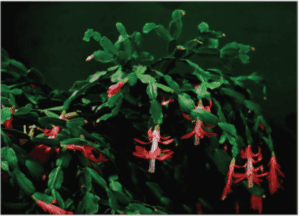By Andrea Knepper, UVM extension master gardener
My grandmother had a green thumb. A self-taught gardener, she cultivated a bountiful garden every summer, tended a large variety of indoor plants and was always ready to experiment with and learn about new varieties. One of my favorite memories of her as a gardener relates to a small, green, succulent-like leaf she found on the sidewalk near her apartment.
We had just arrived for a visit when she found this small leaf. Her excitement seemed excessive as she described how she had found a piece of a Christmas cactus. I watched as she carefully put the leaf in some moist potting soil. I forgot about this incident until some time later when Grandma showed me a lush green plant, which she proudly reported had grown from that small leaf she picked up from the sidewalk.
Christmas cactus (Schlumgera bridgesii), and its close relative, the Thanksgiving cactus (Schlumgera truncata), appear for sale in garden centers at this time of year. They make wonderful gifts as they are easy to care for and, with a bit of knowledge, can be coaxed to rebloom with modest effort.
Identification of these cacti can be made by examining their leaf segments. Both types have projections along the edge. The Thanksgiving cactus leaf projections are pointed while those of the Christmas cactus are more rounded. Both types bloom in a variety of colors, most commonly red, pink, purple and white.

The Christmas cactus with its showy flowers that bloom in winter is a popular, easy-to-grow holiday plant.
They are native to the rainforests of Brazil where their roots anchor them to tree branches or rocky outcrops. Because of this heritage, their needs are different than other popular succulents.
A succulent potting mix is the best choice for these cacti. Water when the surface of the soil is dry. Christmas and Thanksgiving cacti also prefer a humid environment.
This can be simulated by placing a drip tray of small stones under the plant pot. Keep a small amount of water in the tray to evaporate. The pot should not be submerged in the water but sitting atop the stones. These plants prefer bright light, but not direct sunlight.
Both the Christmas and Thanksgiving cactus are short-day plants. To encourage them to bloom, they must have a minimum of 12 hours of darkness and cooler temperatures, ideally in the 50-60 degree Fahrenheit range, for about six weeks. Once buds begin to appear, you can return the cactus to its usual location. Do not fertilize your cactus while it is in bloom.
These beginner-friendly cacti are relatively disease-free. The most common problem is stem or root rot, caused by excessive moisture. This easily can be avoided by using well-draining soil, such as a succulent potting mix, and allowing the soil to dry between waterings. There are reports of lovingly cared-for Christmas and Thanksgiving cactus living for decades.
Christmas and Thanksgiving cacti prefer to have their roots fit snugly in their pot, so replanting is only necessary every three to five years.
In addition to being easy to care for, both are excellent candidates for propagating from cuttings. Take a cutting of one or more leaf segments and simply allow to dry out for a couple of days. Once dry, place the cutting in moist soil. After roots have developed, which takes a few weeks, transplant into succulent potting mix and water as you would for an established plant.




